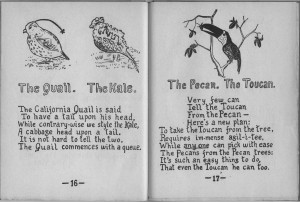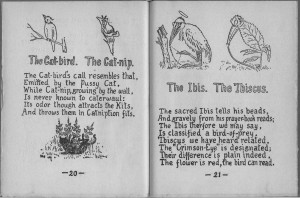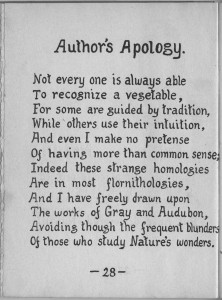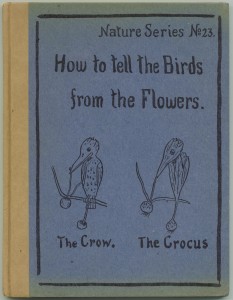
As with animated cartoons, the best children’s books are ones that satisfy both the children and the adults. Paul Elder published a number of innovative children’s books, but perhaps the most delightful is How To Tell the Birds From the Flowers by Robert Williams Wood, which appeared in 1907.
There is no traditional typesetting in the book; everything was drawn and lettered by Wood. Each page contains drawings of a bird (for example, the catbird) and a flower (the catnip), plus an amusing poem on how to distinguish them. It’s a perfect bedtime storybook.
The California quail is said
To have a tail upon his head,
While contrary-wise we style the Kale,
A cabbage head upon a tail.
It is not hard to tell the two,
The Quail commences with a queue.
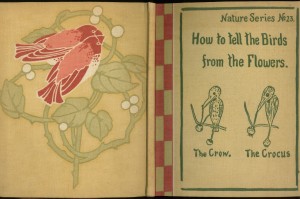
Robert Williams Wood (1868-1955) was a professor of physics at Johns Hopkins University from 1901 until his death. He specialized in optics and has been described as the “father of both infrared and ultraviolet photography”. In 1903, Wood invented an optical filter glass which allows ultraviolet and infrared light and pass through, but blocks most visible light. He used this special glass to make a device called a “Wood’s lamp,” for use in dermatology to diagnose certain skin conditions which fluoresce under ultraviolet light. Today we call these lamps “black lights,” though because of technology improvements black lights now use different filter materials in the glass.
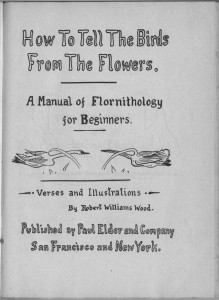
Although the cover says “Denatured Series No. 23”, that name was concocted for this book and there are no earlier “denatured” titles. Wood continued the series in 1908 with Animal Analogues as Denatured Series No. 24, but he wrote no further books like it.
Instead, Wood co-wrote two prescient science fiction books with Arthur Cheney Train. The first, The Man Who Rocked the Earth (1915), is known for describing the effects of an atomic explosion thirty years before the first atomic bomb was created. Its sequel, The Moon Maker (1916), describes interplanetary space travel, including a plan to send a spaceship to destroy an asteroid that’s on a collision course with Earth.
Update, April 2017: In 1917, Dodd, Mead and Company copyrighted a new edition entitled “How To Tell The Birds From The Flowers, and Other Wood-cuts.” Your editor has seen a 19th edition of this title from 1939, so it was clearly a very popular title for Dodd Mead. Paul Elder was still publishing his own books in 1917, and it’s unclear how he lost the publishing rights.
